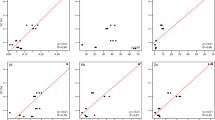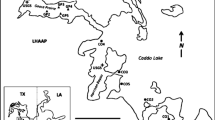Abstract
To test the hypothesis that sediment would have a synergistic effect on the toxicity of lead to cladocerans, we performed life table demography experiments with two pelagic (Diaphanosoma birgei and Moina micrura) and one littoral (Alona rectangula) cladoceran species. Life table demography experiments were conducted at three levels of turbidity (0, 17 and 170 NTU) and six concentrations of lead (as PbCl2) from 0 to 0.71 mg l−1. Median lethal concentrations (LC50) for A. rectangula, D. birgei and M. micrura were 7.06 ± 0.39, 3.16 ± 0.25 and 3.24 ± 0.69 mg l−1 of Pb. Life table study showed that in general, the presence of sediments in test jars allowed an overall increase of 20–75% in both survivorship and reproduction of the cladoceran species exposed to different concentrations of Pb. At 0.04 mg l−1 of Pb, the population growth rates were 0.127 for A. rectangula, 0.037 for D. birgei and 0.471 d−1 for M. micrura in the absence of sediments but were elevated in their presence (0.309, 0.141 and 0.722 d−1, respectively). The data have been discussed in relation to their importance in shallow, turbid Mexican waterbodies.





Similar content being viewed by others
References
Arruda JA, Marzolf GR, Faulk TT (1983) The role of suspended sediments in the nutrition of zooplankton in turbid reservoirs. Ecology 64:1225–1235
Borowitzka MA, Borowitzka LJ (1988) Micro-algal biotechnology. Cambridge University Press, United Kingdom
Brand-Arzamendi RK (2002) Toxicidad aguda y crónica del cadmio y mercurio en el crecimiento poblacional del cladócero Alona rectangula. Thesis, UNAM, Mexico City
Calabrese EJ, Baldwing LA (2003) Inorganics and hormesis. Crit Rev Toxicol 33:215–304
Calow P (ed) (1993) Handbook of ecotoxicology. Blackwell Science Publishers, London
Cervantes C, Moreno-Sánchez R (1999) Contaminación ambiental por metales pesados: impacto en los seres vivos. A.G.T. Publishers, S.A., Mexico City
Clesceri LS, Greenberg AE, Eaton AD (1999) Standard methods for the examination of water and wastewater (20th edn), Washington
De Gregori H, Pinochet HC, Arancibia MJ, Vidal AB (1996) Grain size effect on trace metals distribution in sediments from two coastal areas of Chile. Bull Environ Contam Toxicol 57:163–170
De La Lanza EG, García-Calderon JL (2002) Lagos y presas de México. A.G.T. Publishers, S.A., Mexico City
Dobsikova R (2004) Daphnia magna in ecotoxicology – a review. Bull VURH Vodnany 40:58–81
Dodson SI, Frey DG (2001) Cladocera and other branchiopoda. In: Thorp JH, Covich AP (eds) Ecology and classification of North American freshwater invertebrates. Academic Press, London, pp 850–914
Finney DJ (1971) Probit analysis (3rd edn), Cambridge University Press, London
Forbes VE, Calow P (1999) Is the per capita rate of increase a good measure of population-level effects in ecotoxicology? Environ Toxicol Chem 18:1544–1556
García GG, Nandini S, Sarma SSS (2004) The effect of cadmium on the population dynamics of Moina macrocopa and Macrothrix triserialis (Cladocera). Bull Environ Contam Toxicol 72:717–724
Ghadouani A, Pinel-Alloul B (2002) Phenotypic plasticity in Daphnia pulicaria as an adaptation to high biomass of colonial and filamentous cyanobacteria: experimental evidence. J Plankton Res 24:1047–1056
Hart RC (1988) Zooplankton feeding rates in relation to suspended sediment content: potential influences on community structure in a turbid reservoir. Freshw Biol 19:123–139
Kammenga J, Laskosky, R (eds) (2000) Demography in ecotoxicology. John Wiley & Sons, New York
Kirk KL, Gilbert JJ (1990) Suspended clay and the population dynamics of planktonic rotifers and cladocerans. Ecology 71:1741–1755
Klerks LP, Lentz AS (1998) Resistance to lead and zinc in the western mosquitofish Gambusia affinis inhabiting contaminated Bayou Trepagnier. Ecotoxicology 7:11–17
Koivistio S (1995) Is Daphnia magna an ecologically representative zooplankton species in toxicity tests? Environ Pollut 90:263–267
Krebs CJ (1985) Ecology: the experimental analysis of distribution and abundance (3rd edn). Harper & Row, New York
Laws AE (2000) Aquatic pollution. (2nd edn), John Wiley & sons, Inc., USA, pp 369–431
Liu XJ, Ni IH, Wang WX (2002) Trophic transfer of heavy metals from freshwater zooplankton Daphnia magna to zebra fish Danio reiro. Water Res 36:4563–4569
Moriarty F (1983) Ecotoxicology. The study of pollutants in ecosystems. Academic Press, London
Nandini S (2000) Responses of rotifers and cladocerans to Microcystis aeruginosa (Cyanophyceae): a demographic study. Aquatic Ecol 34:227–242
Nandini S, Aguilera-Lara D, Sarma SSS, Ramírez-García P (2004) The ability of selected cladoceran species to utilize domestic wastewaters in Mexico City. J Environ Manage 71:59–65
Nandini S, Hernández-Valdez M, Sarma SSS (2005) Life history characteristics of cladocerans (Cladocera) fed on wastewaters. Acta Hydrochim Hydrobiol 33:133–141
Nogrady T, Wallace RL, Snell TW (1993) Rotifera. vol 1. Biology, ecology and systematics. SBP Academic Publishers, The Hague
Pica-Granados Y, Trujillo GD, Hernández HS (2000) Bioassay standardization for water quality monitoring in Mexico. Environ Toxicol 15:322–330
Sarma SSS, Nandini S, Gulati RD (2005) Life history strategies of cladocerans: comparisons of tropical and temperate taxa. Hydrobiologia 542:315–333
Sarnelle O, Cooper SD, Wiseman S, Mavuti KM (1998) The relationship between nutrients and trophic-level biomass in turbid tropical ponds. Freshwater Biol 40:65–75
Schubauer-Berigan MK, Dierkes JR, Monson PD, Ankley GT (1993) pH-dependent toxicity of Cd, Cu, Ni, Pb and Zn to Ceriodaphnia dubia, Pimephales promelas, Hyalella azteca and Lumbriculus variegatus. Environ Toxicol Chem 12:1261–1266
Tessier AJ, Leibold MA, Tsao J (2000) A fundamental trade-off in resource exploitation by Daphnia and consequences to plankton communities. Ecology 81:826–841
Weber CI (1993) Methods for measuring the acute toxicity of effluents and receiving waters to freshwater and marine organisms. (4th edn), United States Environmental Protection Agency, Cincinnati, Ohio
Acknowledgements
Two anonymous reviewers have improved our presentation. We thank CONACyT for a scholarship (GGG-171046) and financial assistance (SN SNI-20520 and SSSS SNI-18726).
Author information
Authors and Affiliations
Corresponding author
Rights and permissions
About this article
Cite this article
García-García, G., Nandini, S. & Sarma, S.S.S. Turbidity mitigates lead toxicity to cladocerans (Cladocera). Ecotoxicology 15, 425–436 (2006). https://doi.org/10.1007/s10646-006-0064-6
Accepted:
Published:
Issue Date:
DOI: https://doi.org/10.1007/s10646-006-0064-6




